Last Updated on July 29, 2025 by Becky Halls
Did you know that pages with more links rank 3.8x higher on Google? Yet, 96.55% of pages fail to get organic traffic due to a lack of backlinks.
If building backlinks feels overwhelming, link-building tools can save time and effort. Here’s a quick look at 10 top tools to help you streamline your SEO strategy:
- 3Way.Social: A backlink marketplace using AI for niche link exchanges.
- Semrush: All-in-one SEO platform with competitive backlink analysis.
- Ahrefs: Known for its massive backlink database and detailed competitor insights.
- Majestic: Offers unique metrics like Trust Flow for backlink quality.
- BuzzStream: Ideal for managing outreach and building relationships.
- BuzzSumo: Great for content discovery and influencer outreach.
- HARO: Free tool to earn backlinks by responding to journalist queries.
- Pitchbox: Automates large-scale outreach while maintaining personalization.
- NinjaOutreach: Focuses on influencer and blogger outreach.
- GroupHigh: Combines influencer marketing with link-building strategies.
Quick Comparison
| Tool | Price (USD) | Key Feature | Best For | Limitation |
|---|---|---|---|---|
| 3Way.Social | Freemium | AI-powered link exchanges | SEO agencies | Limited to link exchanges |
| Semrush | $139.95–$499.95 | All-in-one SEO toolkit | Full-service agencies | High cost for small businesses |
| Ahrefs | $99–$999 | Backlink analysis accuracy | Competitive research | Steep learning curve |
| Majestic | $49.99–$399.99 | Trust Flow metric | Backlink audits | Dated interface |
| BuzzStream | $24–$999 | Outreach management | Teams/agencies | Limited SEO metrics |
| BuzzSumo | $199–$999 | Content discovery | Influencer outreach | Not SEO-specific |
| HARO | Free | High-authority backlinks | Small businesses | Requires quick responses |
| Pitchbox | $165–$675+ | Outreach automation | Large-scale campaigns | Expensive |
| NinjaOutreach | $49–$149 | Influencer database | Blogger outreach | Outdated interface |
| GroupHigh | $179–$499 | Blogger relationships | Earned media campaigns | Pricing not transparent |
Whether you’re a beginner or a pro, the right tool can simplify your link-building process, boost rankings, and save time. Choose based on your budget, team size, and SEO goals.
The Only Link Building Tools you Need (Free and Paid)
1. 3Way.Social
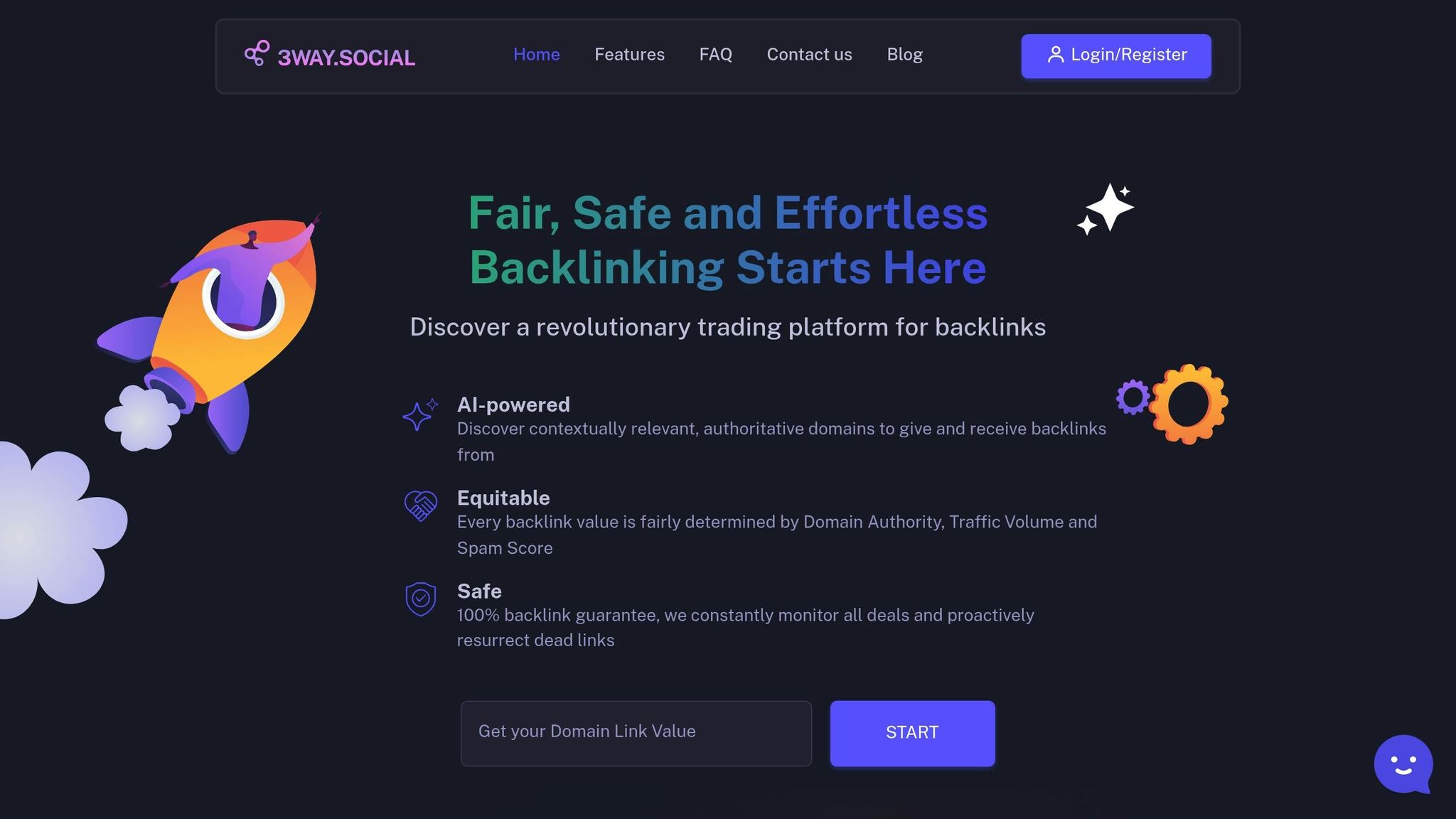
3Way.Social is a marketplace designed for trading backlinks and guest posts, created by Ian Naylor. It allows users to register their domains and engage in buying, selling, or exchanging links within their specific niche.
Features and Capabilities
The platform employs an ABC link exchange strategy to create natural backlink profiles. Its AI-powered matching system evaluates key SEO metrics like Domain Authority and traffic volume to connect users with relevant, high-quality opportunities.
3Way.Social supports various link-building methods, including ABC exchanges, niche edits, and guest posts. All links are do-follow and free from sponsored tags, ensuring compliance with best practices. Regular checks are conducted to verify link permanence and maintain link health.
A user-friendly dashboard provides tools for tracking link exchanges and performance. The platform uses a credit-based system where users can earn credits by offering links and then redeem them for guest posts or link insertions.
Pricing (USD)
The platform operates on a freemium model, offering free access to core link exchange features like domain registration and credit-based transactions. For advanced functionalities, premium and enterprise plans are available. Payments are processed through Stripe, while credit cash-outs are handled via PayPal.
Ideal Use Case
3Way.Social is particularly useful for SEO professionals and agencies. Its credit system simplifies multi-domain management and resource allocation, making it easier to build natural backlink profiles without the need for manual outreach.
Strengths
The platform boasts several strengths, including a vetted network of participants, fair exchanges based on unified SEO metrics, and measurable results. Users have reported a 20% increase in traffic, three times faster ranking improvements, over 10,000 successful exchanges, and a 30% boost in Domain Authority. These features make 3Way.Social an effective tool for enhancing your link-building efforts.
2. Semrush

Semrush provides a robust SEO toolkit designed to support link-building strategies for businesses of all sizes. With one of the largest backlink databases in the industry – 43 trillion backlinks and 390 million referring domains – it offers a wealth of resources for building and managing backlinks.
Features and Capabilities
At the heart of Semrush’s link-building tools is its Link Building Tool, which acts as a one-stop shop for managing outreach campaigns. Users can identify potential link opportunities, send personalized outreach emails, and track campaign progress – all within the platform. To save time, the tool automatically pulls contact details for target websites, making it easier to connect with the right people.
Another standout feature is the competitive backlink gap analysis. This tool highlights backlinks your competitors have that you don’t, helping you create a list of high-value prospects for outreach. By analyzing competitor backlink profiles, users can uncover sites that might be open to linking to their own content.
Semrush also offers a backlink checker that works quickly and accurately to detect new backlinks and pages as they appear online. This real-time monitoring ensures users can react promptly to new opportunities or address potential risks. Together, these tools provide a solid foundation for businesses looking to refine their link-building strategies.
Pricing (USD)
Semrush uses a tiered subscription model with three main plans:
- Pro: $139.95/month ($117.33/month when billed annually)
- Guru: $249.95/month ($208.33/month when billed annually)
- Business: $499.95/month ($416.66/month when billed annually)
The platform offers a 7-day free trial, giving users a chance to explore its features before committing. Additional users can be added to accounts for $45–$100 per month, depending on the plan. Specialized add-ons, like the Lead Generation tool, cost $90/month for 1,000 outreach credits.
Ideal Use Case
Semrush is particularly well-suited for marketing professionals, teams, and larger businesses that need a complete SEO toolkit – not just link-building tools. It’s especially useful for those who want to analyze competitors’ SEO strategies while managing outreach campaigns. Businesses juggling multiple websites or clients will also appreciate its scalability, with the ability to generate up to 3,000 daily reports on the Pro plan and as many as 10,000 on the Business plan.
Strengths and Limitations
Semrush’s biggest strength lies in its all-encompassing approach to link building. It generates extensive prospect lists based on target keywords and competitors and simplifies the outreach process with its built-in workflow.
"If you can only invest in one link building tool, it should be Semrush." – Backlinko
The platform also excels at identifying harmful backlinks. Its Backlink Audit tool flags approximately 10% of backlinks as toxic, helping users maintain a clean and effective backlink profile. For example, when analyzing Backlinko’s website, Semrush’s Site Audit tool revealed a 71% site health score, pointing out areas for improvement in crawlability, indexing, and internal linking.
However, there are a few drawbacks. Each subscription includes only one user account, and there are limits on the number of websites that can be tracked. Additionally, while its traffic analytics is useful, the data isn’t always perfectly accurate. Businesses targeting search engines other than Google may also find its Google-focused data less helpful. Finally, the cost of add-ons can add up quickly, making it less appealing for smaller businesses.
Despite these challenges, Semrush continues to receive high praise, earning a 4.6/5 rating on G2. Users frequently highlight its extensive toolset for managing digital marketing campaigns.
3. Ahrefs

Ahrefs has built its reputation as a powerhouse in backlink analysis, boasting a database of over 35 trillion backlinks. While it began as a simple backlink checker, it has grown into a full-fledged SEO suite, excelling in competitive analysis and link-building research.
Features and Capabilities
At the heart of Ahrefs is Site Explorer, a tool designed for in-depth backlink research. It lets you analyze any website’s backlink profile, uncovering opportunities to replicate competitor strategies. You can also review top-ranking pages for your target keywords to see where their backlinks come from.
Content Explorer is another standout feature, helping you find websites and authors actively publishing in your niche – perfect for targeted outreach. The Link Intersect tool identifies websites linking to your competitors but not to you, giving you a prioritized list of prospects. For large-scale evaluations, Batch Analysis allows you to analyze up to 200 URLs at once.
Ahrefs also offers an Alerts System, which notifies you about new backlinks your competitors gain and flags broken inbound or outbound links. This makes it easier to reclaim lost links and stay ahead in link-building efforts.
Pricing (USD)
Ahrefs offers a tiered subscription model with five main plans:
| Plan | Monthly Cost | Annual Cost |
|---|---|---|
| Starter | $29/month | – |
| Lite | $129/month | $99/month |
| Standard | $249/month | $199/month |
| Advanced | $449/month | $399/month |
| Enterprise | $1,499/month | $999/month |
Lower-tier plans operate on a credit-based system, where actions like applying filters consume credits. Optional add-ons include Brand Radar AI ($89/month), Content Kit (starting at $89/month), and Report Builder ($89/month).
Ideal Use Case
Ahrefs is a go-to tool for SEO professionals and agencies seeking actionable insights. Its robust features make it particularly useful for competitive research and link-building. SEO expert Jason Acidre highlights the importance of efficiency in outreach:
"Finding link opportunities isn’t the hard part. Finding them efficiently across different industries while keeping outreach personalized is the real challenge. Without good systems, you just can’t scale."
Content marketers also benefit from Ahrefs’ ability to identify high-value link opportunities. For example, in 2017, Ahrefs published a study on "How long does it take to rank in Google?" which earned nearly 3,000 backlinks from about 1,700 websites. This demonstrates how Ahrefs can help create and promote linkable assets effectively.
Strengths and Limitations
Ahrefs stands out for its detailed backlink analysis and competitive research. It has earned a 4.6/5 rating as a top SEO tool, with 97% positive reviews and 99% of users recommending it. Users praise its keyword research capabilities, intuitive interface, and powerful filtering options.
However, there are a few drawbacks. Ahrefs lacks an integrated outreach management tool, requiring users to handle email campaigns through separate platforms. The platform also has a learning curve, and its backlink data updates can be slower compared to some competitors. Additionally, the credit-based pricing model for lower-tier plans has drawn some criticism. Despite these challenges, Ahrefs remains a favorite for SEO professionals due to its reliable data and comprehensive analysis tools.
4. Majestic
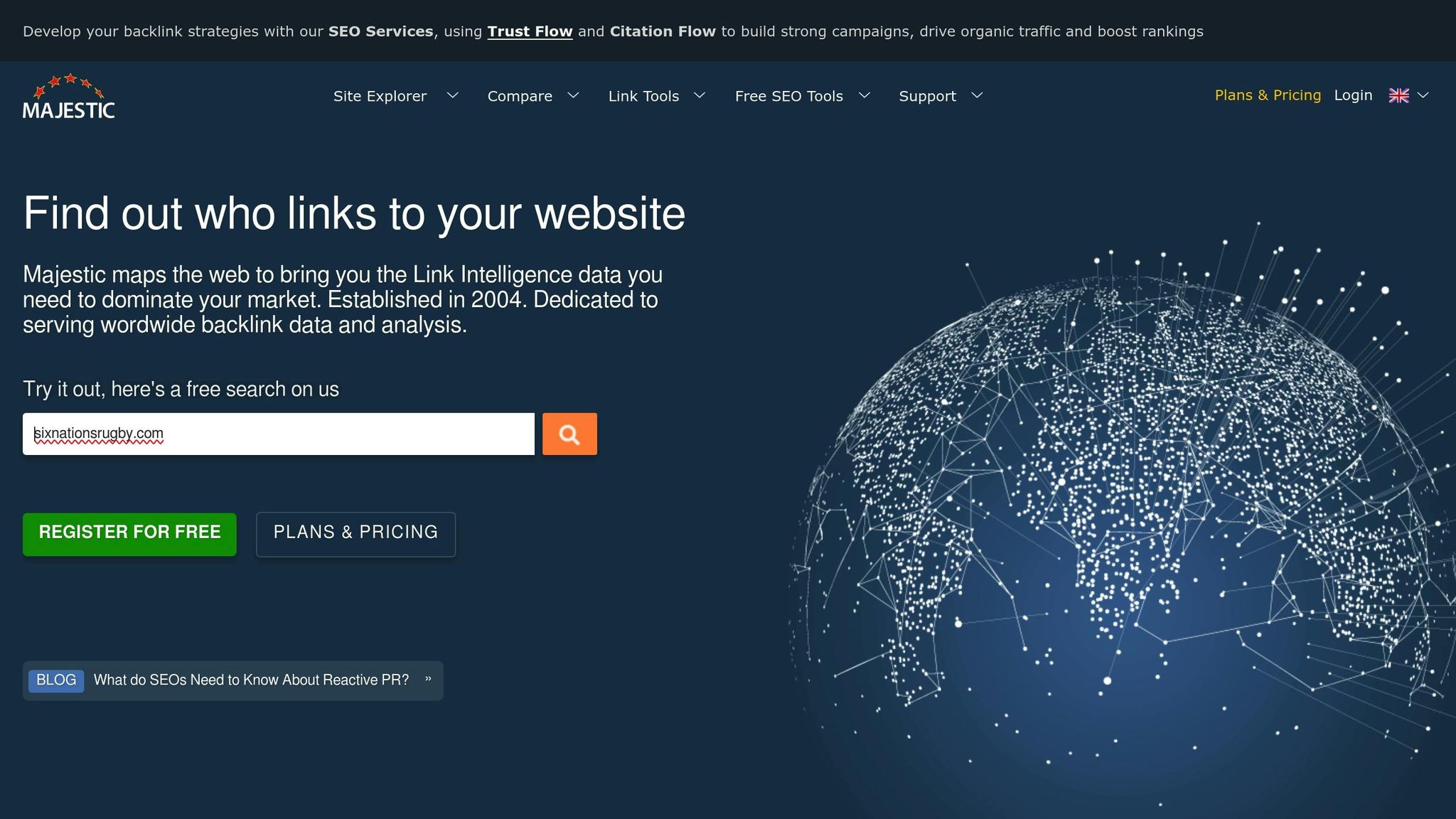
Majestic is all about backlinks. Its Historic Index has been collecting data since 2006, with over 4.5 trillion URLs, while the Fresh Index updates hourly, tracking 323 billion URLs. This makes it a powerhouse for deep link analysis.
Features and Capabilities
Majestic stands out with its Trust Flow and Citation Flow metrics. Trust Flow measures the quality of backlinks based on the trustworthiness of linking sites, while Citation Flow looks at the quantity and influence of links pointing to a website. These metrics are the backbone of its analysis.
The Site Explorer is a go-to tool for digging into backlink profiles, while the Bulk Backlink Checker allows for large-scale analysis. For those targeting specific niches, the Search Explorer identifies link opportunities. If you’re a technical user, the API access lets you integrate Majestic’s data into custom workflows or automate tasks.
Another standout feature is Link Context, which provides details on where links are placed, helping you assess their relevance and value. For quick SEO insights, there’s also a handy Chrome extension.
Ross Tavendale from Type A Media sums up Majestic’s data strength:
"The great thing about Majestic is just that the amount of data that you get and the amount of data points that you get is just completely unparalleled, and taking information out is a very clean and easy thing to do. There’s a ton of connectors where you can literally just click a button and it’s there."
Pricing (USD)
Majestic uses an analysis unit system with three main pricing tiers:
| Plan | Monthly Cost | Annual Cost | Analysis Units |
|---|---|---|---|
| Lite | $49.99 | $499.90 | 1 million |
| Pro | $99.99 | $999.90 | 20 million |
| API | $399.99 | $3,999.90 | 100 million |
The Lite plan is perfect for small businesses or solo SEO professionals. The Pro plan is better suited for agencies managing multiple clients, while the API plan caters to enterprises needing large-scale data integration.
Ideal Use Case
If backlink analysis is your main focus, Majestic is hard to beat. It’s especially useful for SEO professionals conducting competitor research or link audits, agencies monitoring link profiles, and businesses aiming to understand their link-building strategies better.
One digital marketer shared:
"As a digital marketer, I have to analyze many websites & competitors’ backlink audits. And Majestic tool helps me on that to save time and money."
For link builders, the Link Graph feature is a game-changer. It visually maps link networks, making it easier to spot high-value prospects and understand linking patterns in your industry.
Strengths and Limitations
Majestic’s biggest strength is its massive backlink database and its Trust Flow metric, which 24% of link builders rely on to judge link quality. It’s also rated 4.4/5 on Capterra, with users appreciating its affordability and solid competitor insights. Matteo M., a long-time user and CEO in the education sector, shared:
"I have been using Majestic for 10+ years, and I would not switch to any other link analysis tool. It’s simple to use and gets the job done, with little to no frills at all."
That said, Majestic’s focus on backlinks can be a drawback. It doesn’t offer keyword research, rank tracking, or content optimization features, and its interface feels a bit dated compared to newer tools.
If you’re looking for a tool strictly for backlink analysis, Majestic delivers great value. But for a complete SEO solution, you’ll need to pair it with other tools. Majestic’s specialized approach makes it a strong choice for anyone prioritizing detailed backlink insights.
5. BuzzStream
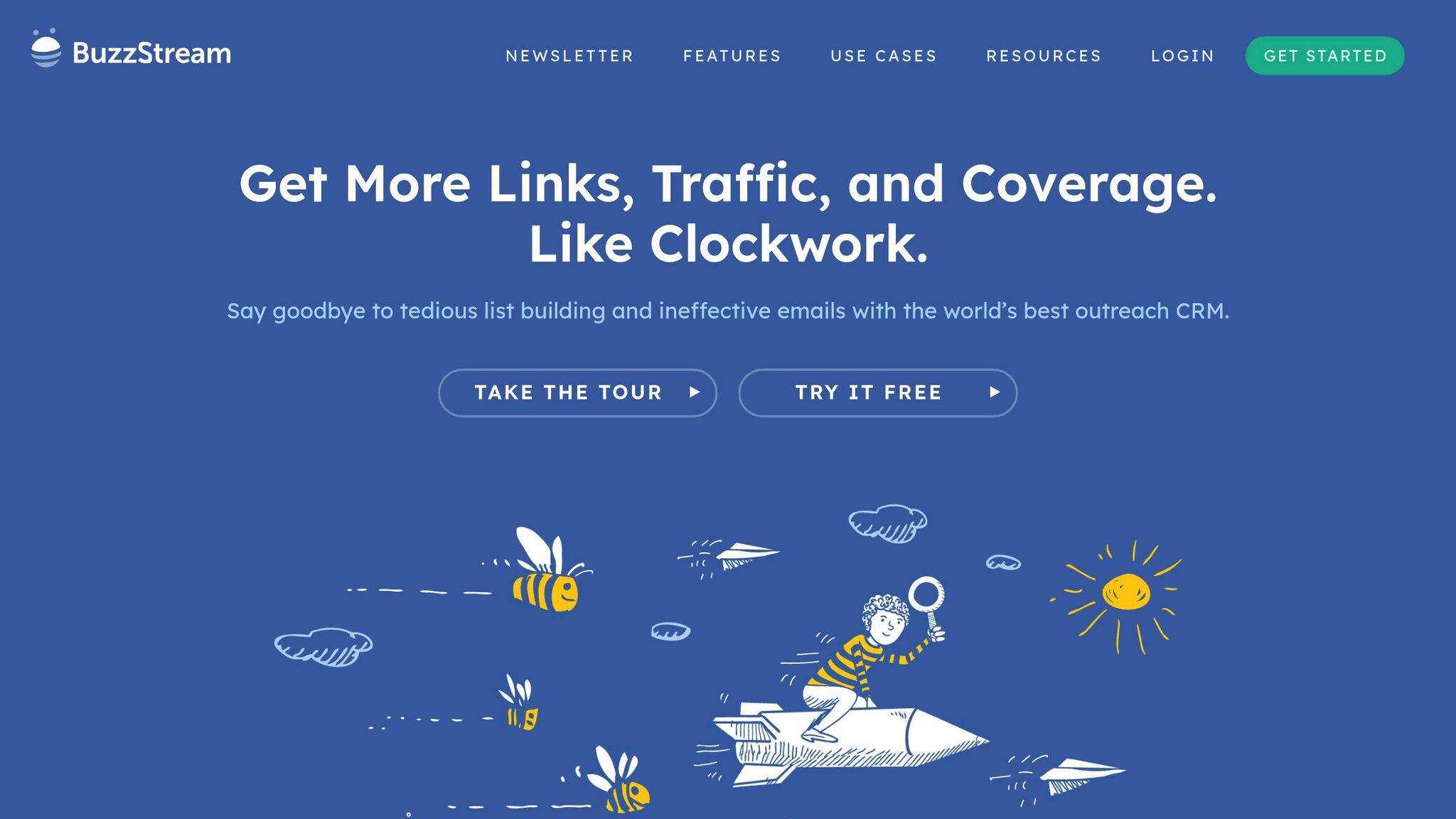
BuzzStream is an outreach tool designed to help you connect with journalists, bloggers, and influencers who can provide quality backlinks.
Features and Capabilities
BuzzStream simplifies outreach by building prospecting lists, automatically pulling email addresses (with Hunter.io integration), sending personalized email sequences, tracking prospect status, and managing follow-ups – all from a single dashboard. Its Buzzmarker Chrome extension lets you add prospects and gather website metrics without leaving your browser.
One of its standout features is its relationship tracking system, which logs every interaction with potential link partners. You can tag relationships, set reminders, and assign tasks to team members, keeping your outreach campaigns organized and efficient. Detailed analytics and reporting tools also allow you to measure campaign performance and fine-tune your strategies.
Wil Reynolds, Founder of Seer Interactive, highlights the tool’s value:
"Buzzstream is hands down the best enterprise class outreach management tool out there. It gives me the easy top down view to make sure we are delivering. I find the tool saves me time and is extremely intuitive."
These features are available across flexible pricing plans to suit different needs.
Pricing (USD)
BuzzStream offers four pricing tiers, tailored to the number of users, contacts, and prospecting searches:
| Plan | Monthly Cost | Users | Contacts | Prospecting Searches |
|---|---|---|---|---|
| Starter | $24 | 1 | 1,000 | 30 |
| Growth | $124 | 3 | 25,000 | 250 |
| Professional | $299 | 6 | 100,000 | 1,000 |
| Custom | $999+ | 15+ | 300,000+ | Custom |
The Starter plan is ideal for solo marketers or small businesses just beginning their link-building efforts. The Growth plan works well for small agencies managing several clients, while the Professional tier caters to larger agencies with dedicated outreach teams.
Ideal Use Case
BuzzStream is especially useful for professionals managing complex outreach campaigns. Its emphasis on relationship building makes it perfect for digital PR, guest posting, and influencer collaborations. By keeping track of past conversations and response rates, it helps you nurture long-term professional connections.
Tabby Farrar, Principal Content & Digital PR Consultant, shares her experience:
"BuzzStream allows our team to be far more efficient than if we’d stuck to using other pitching tools, and gives us access to a variety of useful metrics that make it easier to demonstrate the progress and performance of our campaigns. For our busy team working across a broad range of clients, BuzzStream’s automation, templating and tracking features have proven invaluable – I’ve yet to see an alternative that can match it."
Strengths and Limitations
BuzzStream’s biggest strength lies in its detailed relationship management. Acting as a digital Rolodex, it keeps a thorough record of all communications, making it easy to pick up conversations where you left off. It also shines with its team collaboration features, allowing multiple users to work seamlessly on campaigns. Its value for money is often praised, with ratings of 4.5/5 on Capterra and 4.2/5 on G2. Mihaela O., an affiliate marketing manager, notes:
"I’ve tested much more expensive tools that did much less for the money, so while Buzzstream may not be perfect or the very best out there, I can say without a doubt that it’s worth its price."
However, it does have its drawbacks. New users might face a steep learning curve, and its interface isn’t as sleek as some newer tools. It also lacks robust SEO metrics, so many users pair it with specialized SEO platforms. Some have voiced concerns over price hikes – one founder reported a 25% increase without major new features. Additionally, the social search functionality and email customization options could use some refinement.
6. BuzzSumo
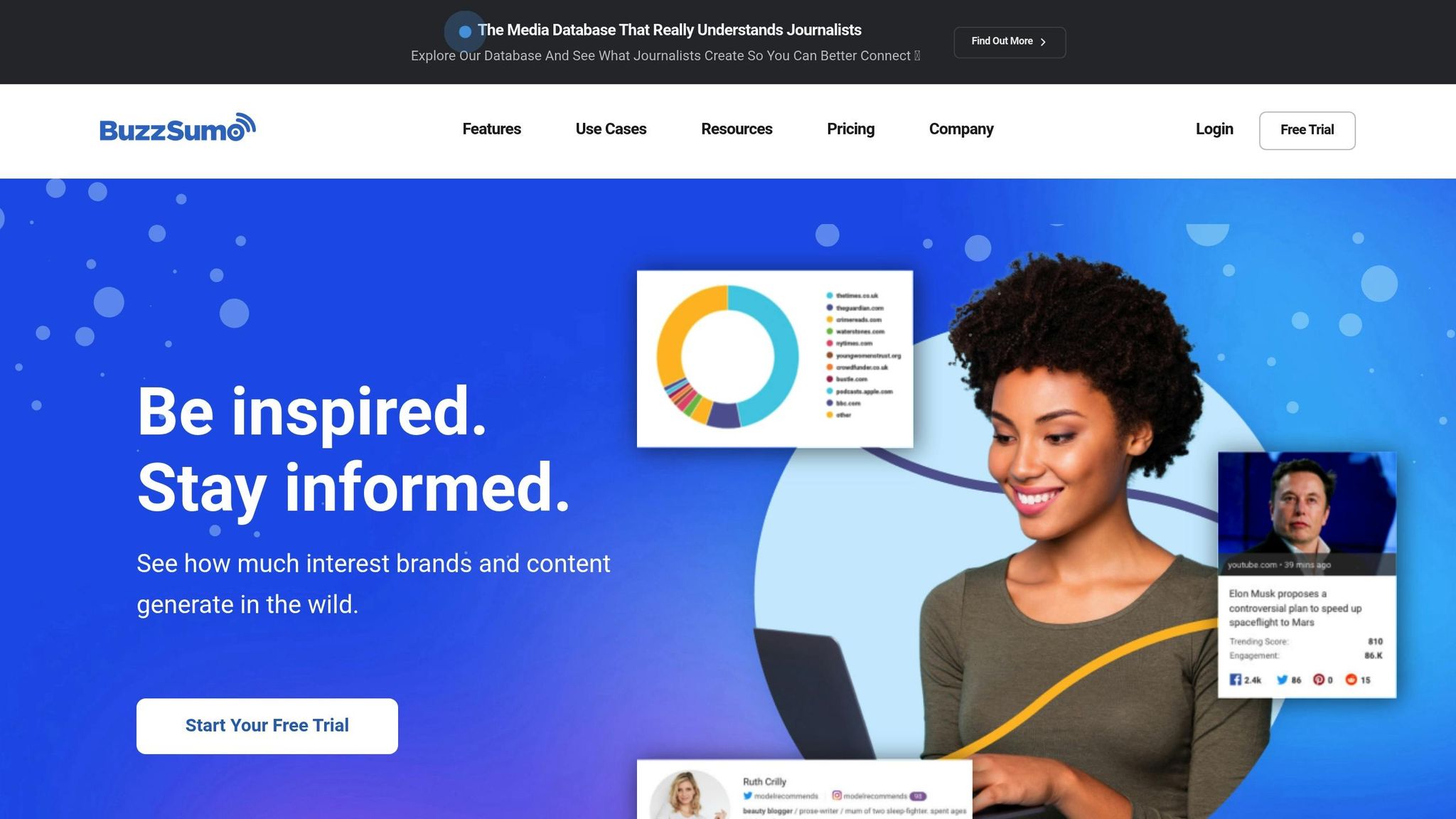
BuzzSumo stands out in the world of link-building tools by combining content insights with influencer analytics, making it a valuable addition to traditional backlink strategies. As a content research and social listening platform, it helps you uncover trending topics, identify influencers, and analyze competitors to enhance your link-building efforts.
Features and Capabilities
With a database of over 8 billion articles, BuzzSumo offers powerful tools for content discovery and link-building. It excels in pinpointing high-performing content within your niche, giving you a clear sense of what resonates with your audience.
The content discovery tool allows you to search for specific keywords and find top-performing articles based on social shares from platforms like Facebook, Twitter, Pinterest, and TikTok. You can refine your search using filters for date, language, country, and content type, making it easier to locate link-building opportunities.
For influencer outreach, BuzzSumo includes a scoring system to evaluate the impact of industry influencers. This feature helps you connect with journalists, bloggers, and content creators who can amplify your content and contribute to your link-building strategy.
BuzzSumo also offers backlink analysis, enabling you to track competitor link profiles and monitor brand mentions across the web. While not as detailed as dedicated SEO tools, this feature still provides actionable insights for discovering new link opportunities and understanding your competition.
Rand Fishkin, Founder & CEO of SparkToro, shares his experience: "I can search for terms/phrases and quickly identify content that’s performing well in a niche or with an audience."
These features are backed by a pricing structure tailored to different business needs.
Pricing (USD)
BuzzSumo offers four pricing tiers, each designed to suit various business sizes and requirements:
| Plan | Monthly Cost | Key Features |
|---|---|---|
| Content Creation | $199 | Content research, trend analysis, basic influencer tools |
| PR & Comms | $299 | Influencer outreach, media monitoring, brand tracking |
| Suite | $499 | Full access, advanced analytics, team collaboration |
| Enterprise | $999 | Custom integrations, dedicated support, unlimited usage |
Plans are billed annually, with the Enterprise plan available only on yearly contracts.
Ideal Use Case
BuzzSumo’s tools and pricing make it especially well-suited for large marketing teams and agencies that rely on data-driven content strategies and influencer marketing. It’s particularly effective in industries where content plays a pivotal role, such as digital publishing, e-commerce, and media. By leveraging its insights, you can create high-quality, linkable content assets that naturally attract backlinks and social shares.
David White, Founder of Connective3, highlights BuzzSumo’s efficiency: "Whatever technology you have fuelling the engine of BuzzSumo seems to be better than most others. It can pick up new links a lot quicker than other link index tools or manual searches. For us, that’s absolutely crucial."
Strengths and Limitations
BuzzSumo’s key strength lies in its ability to provide deep content research and actionable data. It helps you stay ahead of industry trends and offers real-time insights that are invaluable for content planning. Its brand monitoring tools are particularly noteworthy, as emphasized by Brian Dean, Founder of Backlinko:
"In my opinion, BuzzSumo has one of the best brand monitoring tools on the market. And I should know. I’ve tried em’ all. And since I started tracking mentions with BuzzSumo in 2014… I’ve noticed that it finds more brand mentions than any other tool."
The platform has a 4.5/5 rating on Capterra from 146 reviews, with users praising its ease of use (4.4/5) and feature set.
However, BuzzSumo isn’t without its downsides. Its extensive data can feel overwhelming for new users. The pricing also presents a challenge for smaller businesses, with a value for money rating of 4.1/5, which falls below the average for content marketing tools (4.5). Salim K, CEO in the Information Technology and Services sector, notes:
"Their focus seems to be on bigger companies, and I think it’s not suitable for small companies as they may not be able to afford the high prices."
Additionally, while BuzzSumo includes backlink analysis, it lacks the depth and advanced technical SEO features found in specialized tools. The free version is also quite limited, making it hard to fully explore the platform before committing to a paid plan.
Next, we’ll compare BuzzSumo to other leading tools to help determine the best fit for your SEO goals.
sbb-itb-88880ed
7. HARO
HARO (Help a Reporter Out) offers a unique way to build links by connecting journalists with experts, creating opportunities for backlinks from high-authority sites in exchange for valuable insights. Relaunched by Featured.com in April 2025, HARO returned to a free model, making it accessible to all users.
Features and Capabilities
HARO sends out three daily digests filled with journalist queries. By responding with expert insights, you can earn backlinks from respected publications like Forbes and Business Insider. One standout feature is that HARO delivers these updates directly to your inbox – no login required. Beyond individual backlinks, the platform helps build long-term relationships with journalists, which can lead to ongoing collaboration.
HARO also diversifies your link profile by securing backlinks from a variety of high-authority websites, which can improve your site’s credibility with search engines like Google. Timing is critical here; responding to queries within six hours can boost your chances of success by 20%. Like other link-building tools, HARO simplifies outreach while delivering high-quality backlinks.
Pricing (USD)
Since its relaunch in April 2025, HARO has been completely free for both sources and journalists. Brett Farmiloe, CEO of Featured.com, has emphasized this commitment:
"HARO will be free for sources and journalists as long as we own and operate HARO. Quality is everything to us, and the quickest way to kill quality would be to bait and switch our community, or to introduce a business model that creates friction".
This free model marks a shift from the previous Connectively pricing structure, which charged $1 per pitch after 10 free monthly pitches and included subscription plans ranging from $19 to $149 per month. Now, HARO relies on nonintrusive newsletter advertising to remain sustainable without charging users.
Ideal Use Case
HARO is ideal for professionals who can quickly craft targeted, high-quality responses. It’s particularly effective for those aiming to establish thought leadership while gaining backlinks from authoritative publications. Small and medium-sized businesses benefit the most, as HARO provides access to premium websites that are often hard to reach through traditional outreach methods. This aligns with the broader goal of diversifying link profiles for better SEO performance. Consistency and speed are key – many users achieve publication rates of 10–25% by staying active and responding promptly.
Strengths and Limitations
One of HARO’s biggest strengths is its ability to connect you with high-profile publications that are otherwise difficult to access. It’s a cost-effective way to build credibility, increase brand awareness, and earn editorial links without spending hours on cold outreach. The platform saves time by delivering pre-qualified opportunities from journalists actively seeking expert contributions.
However, HARO isn’t without its challenges. Writing tailored responses takes time, and competition has grown as more professionals have discovered the platform. As Luana Spinetti, Freelance B2B blogger and cartoonist, explains:
"Despite being free, HARO demands significant time to craft quality responses".
Additionally, success is not guaranteed. Typical publication rates range between 5% and 15%, and the process requires strategic focus – responding only to queries that are highly relevant to your expertise. Answering irrelevant requests can waste valuable time and effort.
Despite these hurdles, HARO remains a reliable tool for earning editorial links that can improve SEO rankings, especially when combined with other link-building strategies.
8. Pitchbox
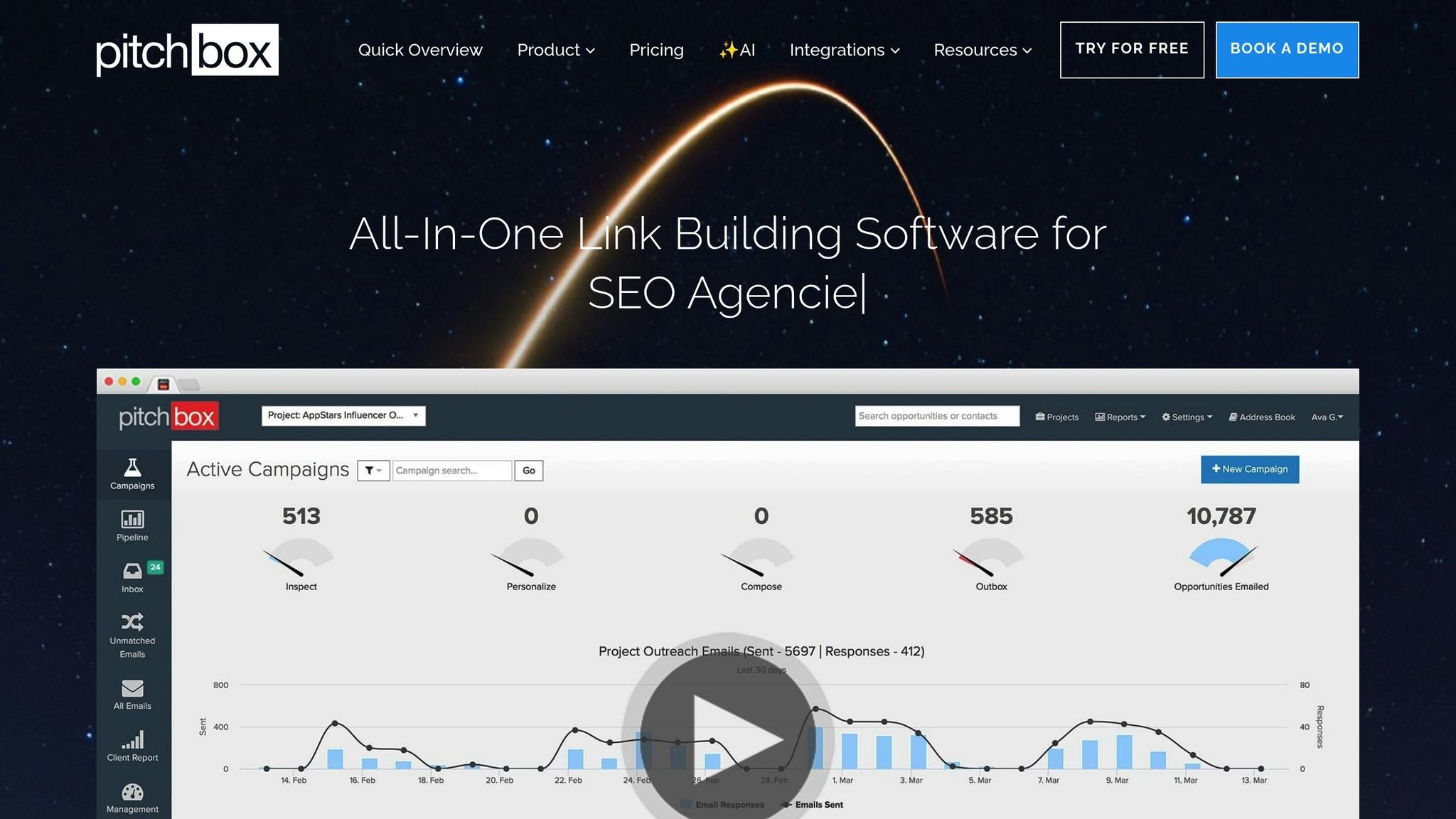
Pitchbox is an all-in-one outreach platform designed to simplify and automate the link-building process, from finding prospects to managing campaigns. By integrating directly with Google search operators and SEO metrics, it allows users to create targeted prospect lists without the need to switch between tools. This makes it a great option for agencies managing multiple campaigns at once, as it bridges the gap between manual effort and scalable automation.
Features and Capabilities
Pitchbox stands out for its ability to automate outreach while keeping personalization intact. It uses Google search operators and SEO metrics to streamline prospect discovery, eliminating the need for manual data imports. The platform’s advanced personalization tools can dynamically include specific website details in outreach emails and tailor follow-up messages based on recipient responses.
Its campaign management features are equally robust. Users can create decision-tree campaigns that adjust messaging based on responses and track key metrics like email open rates, response rates, and link acquisition success. Detailed reporting tools help teams, managers, and clients measure ROI and overall campaign performance effectively.
Pricing (USD)
Pitchbox offers four pricing plans tailored to different business needs and outreach volumes:
- Pro Plan: $165/month. Ideal for link builders managing a single website. Includes 2 users, 2 email accounts, 2,000 outreach emails, 1 workspace, 25 campaigns per month, 1,000 prospecting searches per month, 50,000 contacts, and 600,000 data credits annually.
- Advanced Plan: $420/month. Designed for growing agencies, it provides unlimited users, 6 email accounts, 5,000 outreach emails, 25 workspaces, 1,000 campaigns per month, 5,000 prospecting searches per month, 200,000 contacts, and unlimited data credits.
- Scale Plan: $675/month. Best for teams scaling outreach efforts. Includes unlimited users, 15 email accounts, 15,000 outreach emails, and unlimited workspaces, campaigns, prospecting searches, contacts, and data credits.
- Enterprise Platform: Custom pricing with features like single sign-on (SSO), service level agreements (SLA), and dedicated support.
Annual subscriptions come with a 15% discount, and a free trial with expert team training is available.
Ideal Use Case
Pitchbox is best suited for agencies with established workflows and a need to manage multiple campaigns efficiently. Its automation features make it a powerful tool for scaling outreach efforts while maintaining a personal touch. Stephan Spencer, co-author of The Art of SEO, praises the platform’s capabilities:
"Pitchbox is THE answer to scaling your outreach efforts. It handles all aspects from the prospecting to the emailing to the tracking and managing the workflow. I highly recommend it to anyone who’s serious about building links and their online reputation."
For teams that value personalization and performance tracking, Pitchbox is especially effective. Christoph Cemper, founder of Link Research Tools, highlights its versatility:
"If you’re serious about personalization, automation and performance tracking of your outreach team, then look no further – Pitchbox finally answers all of your burning questions for software that helps you nurture your prospects, be it for PR, link building or toxic link removal."
Strengths and Limitations
Pitchbox’s biggest strength is its ability to automate the outreach process without sacrificing personalization. It simplifies prospect discovery, campaign creation, and results tracking, while its detailed reporting and responsive customer service add to its appeal.
However, the platform does come with a learning curve and requires a significant investment of both time and money. Users must establish quality assurance processes to ensure outreach efforts remain effective at scale. Managing large campaigns can also become overwhelming, and Pitchbox’s link index is smaller compared to tools like Ahrefs or Semrush, meaning some backlinks might not show up in reports.
Rhea Drysdale, CEO of Outspoken Media, sums up the tool’s value:
"Outspoken Media loves Pitchbox! It saves us time, which frees up our client’s budgets for more results whether we’re reaching out to the media and bloggers, or cleaning up links. Our favorite features include reliable contact discovery, scheduled follow-up, industry-leading email integration, and reporting on all phases of the outreach process. Its ease of use and prompt customer service make Pitchbox an essential tool for our digital marketing agency."
9. NinjaOutreach
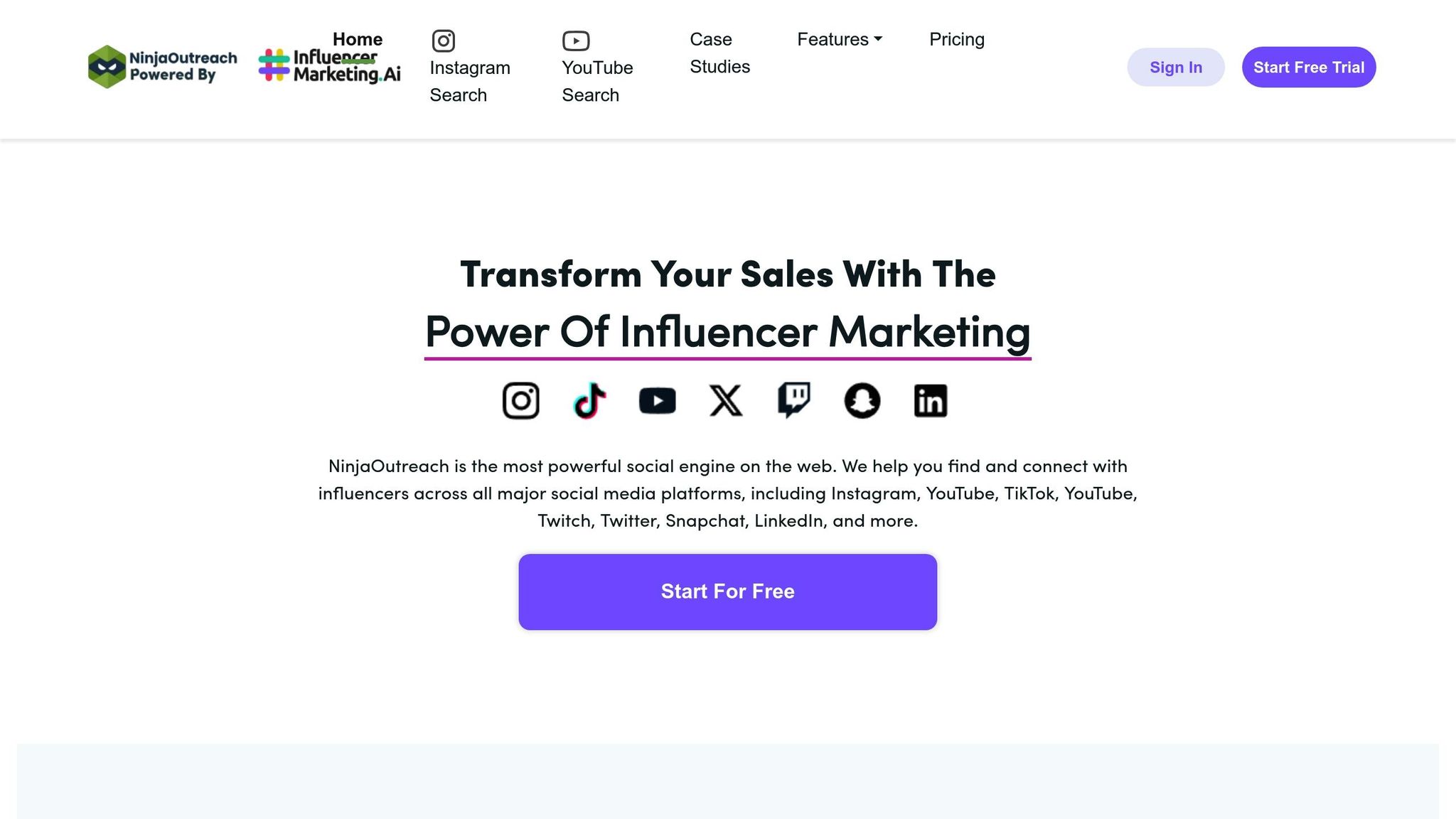
NinjaOutreach stands out as a specialized tool for influencer marketing and blogger outreach. It complements other link-building tools by combining influencer discovery with robust outreach management. This makes it a strong choice for businesses aiming to establish meaningful connections with content creators and industry influencers.
Features and Capabilities
NinjaOutreach boasts a vast database of influencers, bloggers, and business profiles across various industries, simplifying the process of finding the right contacts for link-building campaigns. Its advanced search filters and built-in CRM allow users to target prospects based on metrics like engagement rates, follower count, and niche relevance. The CRM also keeps outreach data well-organized and easy to access.
The platform’s outreach management features cover the entire communication journey. Users can create customized email templates, set up automated follow-up sequences, and track response metrics. Additionally, it includes scheduling tools that let users book appointments with influencers directly within the system.
For teams already using other systems, NinjaOutreach’s CRM integrates seamlessly, enabling them to maintain their workflows while benefiting from the platform’s features. By centralizing outreach activities, it reduces the need for juggling multiple tools, simplifying campaign management.
Pricing (USD)
NinjaOutreach offers two pricing plans, with options for monthly or annual billing:
- Flex Plan: Includes 10,000 emails per month, 1,000 contacts, and 1 user seat. Costs $389 per month for monthly billing or $49 per month when billed annually.
- Pro Plan: Includes 15,000 emails per month, 4,000 contacts, and 3 user seats. Priced at $649 per month for monthly billing or $149 per month with annual billing.
Ideal Use Case
This platform is ideal for businesses and agencies focused on influencer-based link building. It’s particularly effective for teams experienced in influencer marketing who can leverage its extensive database for blogger outreach campaigns. Companies with dedicated outreach teams will find its contact management and automation tools especially helpful for managing multiple relationships and tracking campaign results.
Strengths and Limitations
NinjaOutreach combines automation with personalization, which is a major advantage for streamlining outreach campaigns. Its focus on influencer and blogger outreach is a key strength, as it provides tools to manage and personalize campaigns effectively.
However, user feedback highlights some notable drawbacks. Several reviewers have reported issues with outdated databases, basic functionality, and an interface that feels behind the times, which can hinder productivity. Additionally, there have been complaints about customer service and billing practices. One user, John S., shared his frustration:
"My experience was an absolute disaster. I wish I had read the other negative reviews about the way they do business before I signed up for their trial."
With a Capterra rating of 3.7 out of 5 based on 64 reviews, NinjaOutreach offers valuable influencer outreach capabilities but comes with challenges that potential users should carefully consider before committing.
10. GroupHigh
GroupHigh wraps up our comparison as a platform designed to connect businesses with bloggers, traditional media, and social influencers. What sets GroupHigh apart is its focus on relationship management and tracking earned media, making it a solid choice for businesses that want to combine influencer outreach with link-building strategies.
Features and Capabilities
One of GroupHigh’s standout features is its massive database of over 15 million blogger profiles, giving users access to a vast pool of potential link-building contacts. Its influencer search engine allows users to find blogs, media outlets, and social influencers tailored to various campaign goals. Advanced search filters, like "Traffic & SEO" and "Blog content filters", make it easier to target specific audiences and ensure high-quality content alignment. For each influencer, users can review over 50 metrics to evaluate compatibility with their brand.
The platform also simplifies outreach by providing email addresses and social media handles for prospects. Its built-in CRM system helps manage communications by sending emails, saving notes, and handling media kit attachments. Additionally, GroupHigh consolidates brand mentions into visual ROI reports, offering a clear view of campaign performance.
Pricing (USD)
GroupHigh uses a quote-based pricing model, so potential users need to contact the sales team for specific pricing details. While exact costs aren’t publicly listed, industry estimates suggest monthly fees range between $179 and $499. The platform also offers a 7-day free trial and a free version with limited features for those looking to test its capabilities.
Ideal Use Case
GroupHigh is an excellent fit for businesses and agencies that want to integrate influencer marketing with traditional link-building efforts. It’s particularly useful for managing relationships with bloggers, journalists, and social media influencers as part of a broader SEO strategy. By centralizing tools to qualify blogs for outreach, GroupHigh helps marketing teams streamline their earned media campaigns.
Strengths and Limitations
GroupHigh’s strengths lie in its extensive database and robust relationship management tools. The built-in CRM and automated outreach features simplify campaign management, while its reporting tools provide clear insights into ROI. However, some users have reported that the interface can be challenging to navigate, especially for newcomers.
With its combination of data-driven insights and CRM functionality, GroupHigh offers a well-rounded solution for modern link-building campaigns.
Tool Comparison: Pros and Cons
Picking the right link-building tool depends on your specific needs, budget, and team dynamics. Each platform has its strengths but also comes with limitations that might influence your choice. By understanding these trade-offs, you can make a smarter decision that aligns with your SEO goals. Below, we break down key factors to help you match each tool’s capabilities to your requirements.
One of the most important considerations is cost. Your budget will largely dictate which tools are within reach. For instance, free options like HARO are excellent for securing authoritative backlinks, but they require quick response times and constant monitoring. On the other hand, enterprise tools like Pitchbox offer robust automation features but come with a hefty price tag and require thorough quality checks to ensure outreach efficiency.
Team size and collaboration also play a big role. BuzzStream is a standout for managing relationships and enabling seamless team handoffs, making it a great fit for mid-sized agencies with dedicated outreach teams. However, it lacks in-depth SEO metrics, often requiring integration with other tools to get a complete picture.
The quality and accuracy of databases can vary widely between platforms. For example, Ahrefs’ Domain Rating (DR) is a favorite among SEOs, with 69% of surveyed professionals choosing it as the most reliable authority score, according to link-building agency Editorial.Link. Meanwhile, Majestic offers its unique Trust Flow and Topical Flow metrics, though its interface feels less modern than its competitors.
Ease of use is another factor to consider. Moz Link Explorer is great for clients who prefer straightforward metrics and accessible reports, though its link index is smaller compared to heavyweights like Ahrefs or Semrush. Conversely, while Ahrefs offers a comprehensive set of tools, it can be challenging for beginners to navigate.
Some tools shine in specialized functionality. For instance, Hunter.io is known for its fast and accurate contact discovery. Although BuzzSumo isn’t specifically built for link building, it’s useful for finding content ideas and identifying influencers to help generate white-hat links.
| Tool | Monthly Pricing | Key Strength | Best For | Notable Limitation |
|---|---|---|---|---|
| 3Way.Social | Custom | AI-powered domain matching | Equitable link exchanges | Limited to link exchange model |
| Semrush | $139.95–$499.95 | All-in-one SEO platform | Full-service agencies | Too broad for SEO-only focus |
| Ahrefs | $99–$999 | Backlink analysis accuracy | Competitive research | Steep learning curve |
| Majestic | $49–$399 | Trust Flow metrics | Quality control analysis | Less modern interface |
| BuzzStream | $24–$999 | Relationship management | Team collaboration | Limited SEO metrics |
| BuzzSumo | $119–$999 | Content discovery | Influencer identification | Not purpose-built for link building |
| HARO | Free | High-authority opportunities | Media placement links | Requires quick responses |
| Pitchbox | $165–$675+ | Enterprise automation | Large-scale campaigns | High cost, needs strong QA |
| NinjaOutreach | $49–$149 | Influencer database | Blogger outreach | Outdated interface issues |
| GroupHigh | $179–$499 | Media relationships | Earned media campaigns | Quote-based pricing only |
Choosing the right tool often comes down to balancing cost, functionality, and scalability. For example, agencies managing multi-channel marketing efforts might benefit from Semrush’s integrated workflows for SEO, PPC, and content marketing. However, if your focus is solely on SEO, Semrush might feel excessive.
Scalability is another factor to weigh, especially for growing teams. While HARO is perfect for smaller operations, larger teams may require platforms like Pitchbox, which combine automation with personalized outreach. Though these tools demand a higher upfront investment, they’re better suited for agencies handling high outreach volumes.
Before committing to an annual plan, test out free trials when available. Evaluate core features, see how well the tool integrates with your existing workflow, and consider how it aligns with your long-term growth plans.
Conclusion
This guide lays the groundwork for assessing SEO tools based on cost, usability, and their overall influence on your link-building efforts.
Budget plays a significant role in decision-making. Free options like HARO can secure high-authority backlinks without additional costs, while premium tools such as Ahrefs and Semrush offer in-depth data and actionable insights that many professionals deem worth the investment. If you’re serious about link building, dedicating a portion of your SEO budget to high-quality tools can enhance efficiency, accuracy, and outreach results.
Your choice should also reflect your experience level. For beginners, tools with simple, intuitive interfaces – like 3Way.Social, BuzzStream, or Pitchbox – can make navigating SEO tasks much easier. On the other hand, seasoned professionals might prefer comprehensive platforms like Ahrefs, which offer more advanced features despite their steeper learning curve.
Team collaboration is another critical factor. If you’re working solo, straightforward tools without complex collaboration features might suffice. But for agencies or teams managing large-scale outreach campaigns, platforms like BuzzStream or Pitchbox, which support workflow management and relationship tracking, can be game-changers.
The value of backlinks in SEO cannot be overstated. According to research, 58.1% of SEO professionals recognize backlinks as having a major impact on search rankings, while 84.39% report that they enhance brand authority. Google itself ranks backlinks as the third most important ranking factor.
Before committing to any platform, consider taking advantage of free trials to ensure the tool aligns with your primary objectives – whether that’s competitor analysis, relationship management, or automated outreach. Above all, focus on securing quality backlinks, as they hold far more value than simply increasing the quantity.
Investing in the right tools can lead to better rankings, higher traffic, and stronger domain authority. Choose a platform that fits your budget, offers the features you need, and can scale with your goals. With the right combination of tools and strategies, your SEO efforts can reach new heights.
FAQs
How can I find the right link-building tool that fits my goals and budget?
When selecting a link-building tool, start by clarifying your goals. Are you looking to enhance backlink quality, simplify your outreach process, or monitor your progress? Once you know what you need, evaluate your budget and focus on tools that provide the features most relevant to your objectives – without paying for extras you won’t use.
If funds are limited, look for tools that cover the basics or pair manual link-building efforts with budget-friendly options. On the other hand, for more advanced requirements, investing in a tool with strong analytics and automation can save time and improve results. Remember, quality always beats quantity when it comes to building links that boost your SEO.
What are the key advantages of using 3Way.Social for link exchanges?
Using 3Way.Social for link exchanges brings some standout benefits to your SEO efforts. Thanks to its AI-driven domain matching, the platform helps you connect with relevant, high-quality partners, making sure your backlinks are effective and credible. Plus, its secure and easy-to-use link exchange network saves you time while maintaining top-notch quality.
On top of that, 3Way.Social can boost your online visibility, drive more organic traffic, and strengthen your domain authority – key factors that help your site climb search engine rankings faster. It’s a straightforward and efficient tool that takes the hassle out of link building.
What makes tools like Ahrefs and Semrush essential for building an effective SEO strategy?
Ahrefs and Semrush are two powerhouse tools that can shape a winning SEO strategy.
Ahrefs is particularly known for its top-notch backlink analysis and keyword research. It helps you pinpoint high-quality link opportunities and monitor your website’s link profile with incredible accuracy. If improving your backlink game and climbing up in search rankings is your goal, Ahrefs is a tool worth having in your arsenal.
Semrush, meanwhile, offers a wide range of features that go beyond the basics. From content planning to competitor analysis and performance tracking, it covers all the bases. Tools like the On-Page SEO Checker deliver actionable recommendations to fine-tune your site and stay competitive in the U.S. market. When used together, Ahrefs and Semrush give SEO pros the data and insights they need to make smarter decisions and see tangible results.



